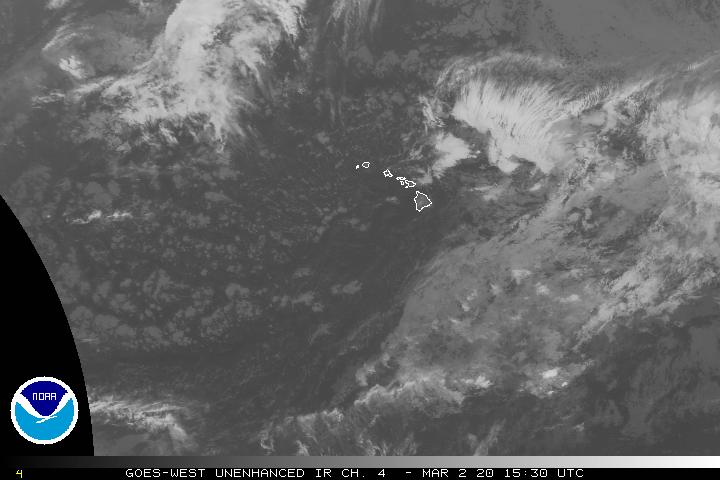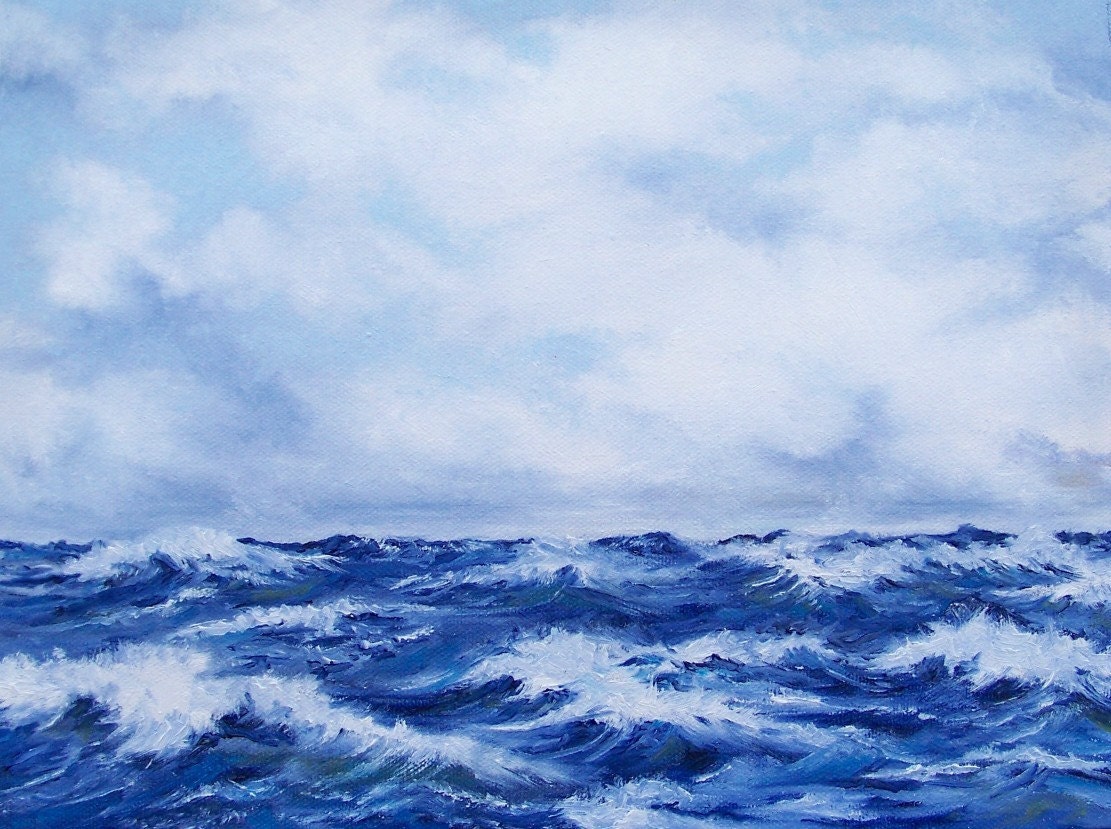Air Temperatures – The following maximum temperatures (F) were recorded across the state of Hawaii Monday…along with the minimums Monday:
83 – 69 Lihue, Kauai
82 – 68 Honolulu, Oahu
84 – 63 Molokai AP
88 – 64 Kahului AP, Maui – broke the high temperature record of 86…set back in 1986
84 – 74 Kailua Kona
87 – 67 Hilo AP, Hawaii
Here are the latest 24-hour precipitation totals (inches) for each of the islands, as of Monday evening:
0.01 Mount Waialeale, Kauai
0.03 Kahuku Trng Area, Oahu
0.00 Molokai
0.00 Lanai
0.00 Kahoolawe
0.04 Kula Branch Station, Maui
0.10 Saddle Quarry, Big Island
The following numbers represent the strongest wind gusts (mph)…as of Monday evening:
18 Mana, Kauai – SE
14 Wheeler AAF, Oahu – SSW
21 Molokai – ESE
13 Lanai – S
20 Kahaloowe – E
14 Hana, Maui – SE
23 Upolu AP, Big Island – NE
Hawaii’s Mountains – Here’s a link to the live web cam on the summit of near 13,800 foot Mauna Kea on the Big Island of Hawaii. This web cam is available during the daylight hours here in the islands…and when there’s a big moon shining down during the night at times. Plus, during the nights you will be able to see stars, and the sunrise and sunset too…depending upon weather conditions.
Aloha Paragraphs

A cold front approaching from the northwest…with high
cirrus clouds moving up from the southwest

High cirrus clouds moving over the islands…
with a frontal cloud band northwest

Clear to partly cloudy, some cloudy areas…with streaks of high cirrus –
and the leading edge of the cold front bearing down on Kauai

Showers have increased locally – looping radar image
Small Craft Wind Advisory…all coasts and channel waters
~~~ Hawaii Weather Narrative ~~~
Southeast to southwesterly breezes tonight into Tuesday…becoming stronger in the wake of a cold front into Thursday. Here’s the latest weather map, showing the Hawaiian Islands, and the rest of the North Pacific Ocean. We find high pressure systems far northeast and northwest of the state. At the same time, there’s a ridge of high pressure over the central islands, which will be pushed offshore to the east of the Islands. In addition, there’s low pressure systems to the north of Hawaii…with a cold front approaching Kauai. Our winds will arrive from the southeast through southwest ahead of the cold front into Tuesday, which will keep thick volcanic haze over us. In the wake of the cold front, arriving Tuesday into Wednesday, we’ll see strong and gusty north to northeast winds for several days thereafter. This wind direction will bring cooler weather into the state, along with blowing the vog away. The outlook calls for trade winds later this week…into the weekend.
Here’s a wind profile…of the offshore waters around the islands – with a closer view
Here’s the Hawaiian Islands Sulfate Aerosol…animated graphic – showing vog forecast
A couple of showers will fall locally tonight…with clouds and showers increasing Tuesday into Wednesday. The atmosphere over the islands remains dry and stable, which is limiting the extent of any shower activity. The forecast continues to suggest we’ll see a cold front moving into our area Tuesday. This front will pass over Kauai Tuesday morning, Oahu late afternoon, Maui County Tuesday evening…and the Big Island early Wednesday. Expect a period of showers along the front, some of which may be briefly heavy. The models go on to point out a notable period of chilly and windy weather in the wake of this cold front…keeping passing shower activity along our north and northeast coasts and slopes for several days. The leeward sides should be in better shape, although locally windy and cool, with an occasional shower being carried into those areas on the gusty winds. Fairly typical, late winter trade wind conditions will return later in the week…with the usual passing windward showers.
Marine environment details: A small craft advisory for strong winds associated with the approaching cold front remains active statewide. There is still the potential for gale conditions to develop late tonight into Wednesday, for the wind prone coastal and channel waters around the Big Island and Maui….particularly the Alenuihaha Channel.
The low pressure system far north, which is associated with the this cold front will generate a north-northwest swell, that may bring high surf advisory level rough surf, along north and possibly west facing shores from tonight through Wednesday. Another north-northwest swell is anticipated later this weekend, bringing possible advisory levels surf for north facing shores then.
The current moderate south-southwest swell is expected to peak today, bringing just below advisory levels surf for south facing leeward beaches. This swell will gradually diminish through Thursday.
Strong and gusty trade winds will generate rough and choppy surf along the east facing shores later this week into the weekend…although surf will likely remain below advisory level.

Here in Maui County...It was mostly clear to partly cloudy early this Monday morning…and there’s still smoke and haze in the air. Here in upcountry Kula, at my place, the air temperature was 48.7F degrees well before sunrise. The temperature at near the same time was 66 degrees down in Kahului under cloudy skies, 73 out in Hana also under cloudy skies, 64 at Maalaea Bay, and 43 atop the Haleakala summit. Meanwhile, Kahoolawe was 66 degrees, 64 at Lanai City, with 68 at the Molokai airport…which was also cloudy.
– 130pm Monday afternoon, under partly to mostly cloudy skies, there’s still lots of volcanic haze. Here in Upcountry Kula, at my weather tower…it’s beginning to spit a few light sprinkles. / The winds are picking up in strength later this afternoon…from the south and southwest.
– Early evening under partly to mostly cloudy skies, and very hazy conditions. The winds, which were beginning to increase during the afternoon, have eased back…although are now kicking up again in the last few minutes here in Kula. The cirrus clouds lite up a nice orange color at sunset, if you could see them through the vog!
World-wide tropical cyclone activity:
>>> Atlantic Ocean: The last regularly scheduled Tropical Weather Outlook of the 2015 Atlantic hurricane season…has occurred. Routine issuance of the Tropical Weather Outlook will resume on June 1, 2016. During the off-season, Special Tropical Weather Outlooks will be issued if conditions warrant. Here’s the 2015 hurricane season summary
Here’s a satellite image of the Atlantic Ocean
>>> Caribbean Sea: The last regularly scheduled Tropical Weather Outlook of the 2015 Atlantic hurricane season…has occurred. Routine issuance of the Tropical Weather Outlook will resume on June 1, 2016. During the off-season, Special Tropical Weather Outlooks will be issued if conditions warrant.
>>> Gulf of Mexico: The last regularly scheduled Tropical Weather Outlook of the 2015 Atlantic hurricane season…has occurred. Routine issuance of the Tropical Weather Outlook will resume on June 1, 2016. During the off-season, Special Tropical Weather Outlooks will be issued if conditions warrant.
Here’s a satellite image of the Caribbean Sea…and the Gulf of Mexico
Here’s the link to the National Hurricane Center (NHC)
>>> Eastern Pacific: The last regularly scheduled Tropical Weather Outlook of the 2015 North Pacific hurricane season…has occurred. Routine issuance of the Tropical Weather Outlook will resume on May 15, 2016. During the off-season, Special Tropical Weather Outlooks will be issued if conditions warrant. Here’s the 2015 hurricane season summary
Here’s a wide satellite image that covers the entire area between Mexico, out through the central Pacific…to the International Dateline.
Here’s the link to the National Hurricane Center (NHC)
>>> Central Pacific: The central north Pacific hurricane season has officially ended. Routine issuance of the tropical weather outlook will resume on June 1, 2016. During the off-season, special tropical weather outlooks will be issued if conditions warrant. Here’s the 2015 hurricane season summary
Here’s a link to the Central Pacific Hurricane Center (CPHC)
>>> South Pacific Ocean: There are no active tropical cyclones
>>> North and South Indian Oceans / Arabian Sea: There are no active tropical cyclones
Here’s a link to the Joint Typhoon Warning Center (JTWC)
Interesting: Warming Arctic being exploited by trawlers – Ice melt in the Arctic Ocean is opening up previously untouched areas to industrial fishing fleets using ecologically risky bottom trawling methods, writes Joe Sandler Clarke. Ecosystems supporting walruses, polar bears, puffins and other sea birds could be stripped bare.
Bottom trawling is widely considered to be the among most destructive fishing techniques, with vast nets catching fish as they are dragged along the sea bed.
Using official data and ship tracking systems, researchers found that large numbers of fishing vessels owned by major companies have taken advantage of melting sea ice to fish in previously impossible to reach parts of the Norwegian and Russian Arctic.
As climate change has caused the Arctic sea ice to recede the trawlers are slowly moving into a part of the Barents sea above 78 degrees north which used to be inaccessible.
Home to Arctic puffins, walruses and Polar bears, the region is one of Europe’s largest marine ecosystems, and has until recently been relatively untouched.
The move comes as fishing in the region increases dramatically. Data from the Norwegian Directorate of Fisheries shows an increase in the amount of fish being caught in the Barents Sea in recent years – from 2% of the Norwegian quota for the region in 2001, to 11% in 2014, the most recent data available.












 Email Glenn James:
Email Glenn James:
jo Says:
Hi Glenn,
Do you use the word vog and haze in your weather descriptions interchangeably? If not, what’s the difference?
Mahalo for all you do.
~~~ Hi Jo, that’s a reasonable question, thanks. I think of haze in terms of vog, marine haze from high surf, and brush and cane burning smoke. I’m not always sure which is which. Therefore, if I have a question, and am not quite sure, I’ve been known to just say it’s hazy.
If there isn’t extra large surf adding marine haze, and there isn’t a brush fire, or there hasn’t been a cane fire, and it’s still way hazy…I assume its vog.
I hope this helps.
Aloha, Glenn